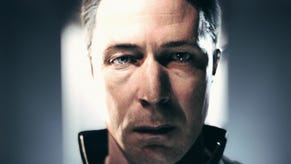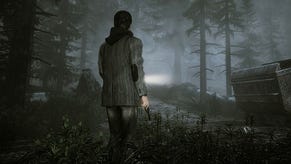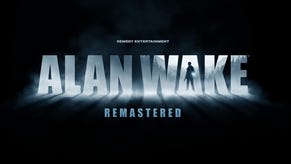Tech Analysis: Alan Wake
Midnight feast.
While frame-rate is capped at 30FPS, should a frame take longer than the requisite 33.33ms to render, the game drops v-sync, producing the tearing effect, which remains on-screen occupying every other frame until the time taken to render the scene drops back. Engine-stressing scenes can see the tear descend down the screen, then back up again as the time taken to generate the framebuffer increases, then scales back. You can see that in evidence throughout the performance analyses dotted throughout this article.
In the run-up to release, Remedy posted in clearly unambiguous terms that tearing shouldn't be an issue in the shipping product.
"The game is locked to 30FPS... All cinematics are guaranteed to run 30 FPS (as we actually background-load the next location, in case there's a location change)," lead technical artist Sami Vanhatalo posted on the Alan Wake community Forums. "If you saw video tearing in the published press material, it's 99 per cent due to video sync issues (eg. PAL video cams or 59.97Hz vs. 60.00Hz screen update). While playing Alan Wake on a Xbox 360, if the game frame-rate drops below 30FPS we resort to screen-tearing (same idea as Gears of War uses)."
At the time of writing this post, towards the end of February, Remedy was working on optimisation.
"We're right now just fixing bugs and making sure nowhere in the game would the frame-rate ever dip below 30FPS," wrote Vanhatalo. "I know there's still a few heavy locations in the game where we resort to dipping below 30FPS, but we're working very very hard to get all those solved."
So, what to make of Remedy's explanation? First off, the tearing in the published press materials isn't down to dodgy capture cards or cameras. It is without doubt from the game itself. As regular Digital Foundry readers will know, internet video operates at 30FPS, while the base output of the console is double that. In games like Alan Wake (double-buffered, capped at 30FPS), torn frames can crop up on every other frame, so simply decimating the throughput and eliminating half the output will do one of two things: it will either remove torn frames completely or else they will be displayed in turn for twice as long as they should be.
Video producers putting together assets for the game therefore face something of a difficult decision. They can either remove the torn frames completely, thus making the game look better than it actually is (as in Digital Foundry's own Uncharted v-sync clean-up video), or retain them and make it look significantly worse than it does when playing in "real life".
Where Remedy does deserve kudos is in the fact the game maintains 30FPS to the point where dropped frames are mostly unobservable to the human eye. This gives the game a smoothness and uniform response rate that can only work to the player's advantage. It's also interesting to note that the darkness and muted colour scheme in Alan Wake also serves to diminish the impact of screen-tearing. The effect vanishes in the vast majority of the daytime scenes, as you would expect when engine load diminishes - the requirements of that astonishing volumetric fog system, for example, aren't so much of an issue in these scenes.
Here we have extended FPS analysis from a range of scenes across three of the game's episodes, but concentrating on combat where we can expect to see the engine really put through its paces. You can get an idea of the extent of the tearing, plus of course you can see just how consistent the frame-rate is at points in the game where arguably it is at its most important.
In terms of how it stacks up in the overall gameplay experience, here's a more lengthy sample of gameplay. Eurogamer ran the first 10 minutes of Alan Wake earlier this week. This video actually emanated from one of our TrueHD capture stations, meaning that the same footage is ripe for Digital Foundry analysis, thusly...
Playing Alan Wake, there's an odd sense of schizophrenia about the game's technical make-up. Long-time followers of Remedy's efforts will know that Wake was originally designed as a free-roaming open-world game. The final product is anything but - it focuses on a tightly defined, very narrow narrative that is supremely linear.
There is the illusion of the open world in places, but make no mistake, the sandbox element has been significantly dialled back in favour of an item-collection mechanism that sees manuscript pages and coffee thermos flasks secreted about the levels. This is clearly a "Plan B" and it would be fascinating to learn more about the original concept Remedy envisaged and why it was jettisoned in favour of the game we have today.
However, there still remain some elements from the sandbox game that can be found in the final shipping product. First of all there is the inclusion of cars: not just the vehicles that the ever-present compass bearing guides you towards, but other vehicles abandoned on the road that you can take control of. Different cars, different handling models, none of them really necessary to a linear narrative - however, their inclusion makes perfect sense from a time in the game's development when the expansive area of Bright Falls could be explored at will and you needed a fast means of transport to get around.
There's also the fact that the engine itself is capable of rendering some phenomenal draw-distances. Some of the shorter engine-driven cut-scenes (for example, Wake on a rope-bridge, with the view panning out) show some stunning vistas, and there's also a mountaintop look-out complete with telescope that allows you to survey the environments.
According to Remedy, the engine itself is capable of rendering with a 2km distance. We can well believe it. After the initial action scene at the start of the game, Alan Wake's story switches back to his arrival in Bright Falls via ferry, accompanied by his wife. While many sections within the game give us some idea of just how far this engine can generate beautiful scenery, this small episode - taking place in daytime - with no atmospheric effects obscuring the view, perhaps give some idea of what the tech can do.
















